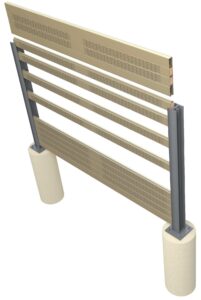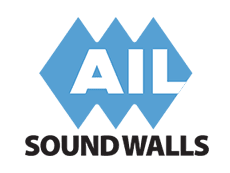It is important to consider the full life cycle performance and longevity of the sound wall
Environmental noise control barriers are frequently used to reduce noise propagation alongside roads or rail lines. Sound wall systems are an effective means by which the transmission of noise can be mitigated. Not all noise barrier walls are created equal, however. Various aspects of sound wall design and construction can affect its cost and effectiveness over its life cycle.
The first purpose-built noise barriers in North America were installed in California in 1968. Since then, noise barriers have steadily grown in popularity. In fact, noise barriers are the dominant type of mitigation measure adopted in most states to reduce unwanted road or rail noise.
With the ever-increasing use of sound barriers, research into their design, performance and cost efficiency has also increased. While early noise barrier wall systems were massive and more costly structures made of wood, metal or concrete, the market has evolved and matured to favor more efficient and sustainable solutions — often with more sound absorptive technology or materials.
Cost of materials, installation and maintenance of the sound barrier wall
When looking into the relative costs of a sound barrier wall, it’s important to look at the whole picture, including the cost of the materials, the cost of the installation labor and machinery and the ongoing cost of maintaining it through its design service life.
Early sound walls and enclosures were often made from wood, metal, concrete or other composite materials. Over time, the drawbacks of noise barriers made from these materials became evident as they began to show wear and degradation from weather and other factors. Wood was prone to rot; metal could rust; concrete was susceptible to cracking and break-up from repeated freeze/thaw cycles. In fact, many of the earlier sound walls are being replaced today by more sustainable and effective solutions, such as lightweight PVC wall panels.
Today’s lightweight PVC noise barrier wall systems offer many cost benefitsModern innovations in noise barrier wall systems, like those from the AIL Sound Walls R&D team, are leading the way to more cost-effective and sustainable sound barrier wall construction solutions compared to other materials.

Lightweight PVC construction
AIL technology offers installation benefits:
- Tongue and groove panels stack within steel posts
- Quick and easy to install
- Adapts easily to site variations and design requirements
- Available as Silent Protector (Absorptive) or Tuf-Barrier (Reflective) noise barrier walls
Lower installed cost
Cost savings are realized due to smaller and lighter material:
- Smaller foundations mean lower foundation costs
- Install with local labor and less lifting equipment
- Adaptable to a variety of footing types
- XL Series offers panel lengths of up to 16′ (4.9 m) for fewer panels, posts and foundations
More resilient and sustainable material
PVC offers long-term sustainability and durability:
- Made from recycled and recyclable PVC
- Highest percentage of recycled material
- A readily renewable and recyclable product
- Minimized water consumption in manufacturing
- Optimized shipping for reduced CO2 emissions
- Long product lifespan
- Excellent fire-resistant properties
- Smaller footprint, better urban land use
Durable and low maintenance
The cost savings increase the longer PVC sound wall systems are in place:
- PVC systems are impervious to rain, snow and ice and are unaffected by de-icing salts
- Will not rust, rot or stain
- Wind load tested for hurricane-force winds
- Meet accelerated test requirements for durability
- Graffiti- and tagging-resistant
- Designed to meet applicable design codes (AASHTO, IBC, CSA)
- Meet ASTM F3459-21 Standard Specification for PVC Exterior Profiles used for Sound Walls
Smart owners, specifiers, planners and engineers look at the total cost of the sound barrier wall over its full life cycle and soon discover that lightweight PVC sound barrier walls, like those from AIL Sound Walls, are the go-to choice for a better ROI. Not only do they offer a better bottom line on the project installation costs, but they also set the stage for decades of low-maintenance service.
AIL Sound Walls can also increase the value of protected properties
Independent studies have shown that properties near busy highways or railways protected by an attractive noise barrier wall have a higher value than those that don’t. This allows developers and homeowners to sell residences for higher prices.

AIL Sound Walls are available in both absorptive or reflective systems
Unlike noise barriers made from other materials, AIL Sound Walls are available as either Silent Protector (Absorptive) or Tuf-Barrier (Reflective) systems. With Sound Transmission Class (STC) ratings of up to thirty-nine, these sound barrier systems are engineered for maximum sound reduction of environmental or ambient noise such as traffic, manufacturing, industrial or commercial noise. AIL Sound Walls offer enhanced aesthetic solutions with a variety of attractive colors and even wood grain textures and finishes.

An AIL Sound Walls representative can help you save
The AIL Sound Walls team is experienced in finding alternative solutions that offer your projects the same functionality and quality at a better value. We call it value engineering and it is a systematic, organized approach to providing necessary functions in a project on a faster schedule and at the lowest cost. It promotes the substitution of materials and methods with less expensive alternatives without sacrificing functionality, performance or safety.
Our value engineered noise barrier walls for engineering solutions could include:
- Wider post spacing through our Silent Protector XL or Tuf-Barrier XL Series
- Specialized footing designs and pile systems to reduce materials and labor
- Custom attachments and fittings to simplify structure-mounted solutions
There’s an AIL Sound Walls specialist ready to help you value engineer a better solution for your sound-mitigation project — and the sooner they get involved in the process, the more you may save.
Call toll-free 1-866-231-7867 to get started.






